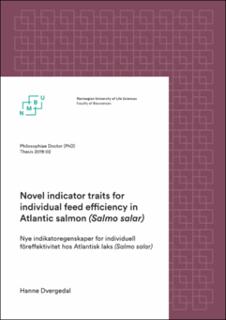| dc.contributor.advisor | Klemetsdal, Gunnar | |
| dc.contributor.advisor | Ødegård, Jørgen | |
| dc.contributor.advisor | Øverland, Margareth | |
| dc.contributor.advisor | Mydland, Liv Torunn | |
| dc.contributor.author | Dvergedal, Hanne | |
| dc.date.accessioned | 2022-12-19T08:50:44Z | |
| dc.date.available | 2022-12-19T08:50:44Z | |
| dc.date.issued | 2019 | |
| dc.identifier.isbn | 978-82-575-1549-2 | |
| dc.identifier.issn | 1894-6402 | |
| dc.identifier.uri | https://hdl.handle.net/11250/3038390 | |
| dc.description.abstract | Selective breeding for enhanced feed efficiency in aquaculture production has so far been performed indirectly, largely through selection for an improved growth rate. However, a substantial fraction of the genetic variation in feed efficiency is due to other factors than growth, and there is room for improvement. Direct selection for improved feed efficiency would be beneficial. This requires both individual growth and feed intake routinely recorded for a large number of individuals. Recording of individual feed intake in fish is, however, extremely challenging. Hence, the overall aim of this study was to identify novel phenotypes that can be used as indicators for individual feed efficiency in fish breeding.
Stable isotopes enhance the ability to trace the processes involved in metabolic breakdown and growth of new tissue that occurs after a dietary switch between diets that differ in their isotope profiles. In one experiment with full-sib families kept in separate tanks and feed efficiency recorded on a tank level, growth rate and sampling day explained 62% of the between-tank variation in feed efficiency, and by extending the regression model with change in isotope profiles, the model was able to explain as much as 79% of this variation. This thesis proposes several new indicator traits with potential for large-scale evaluation of feed efficiency. By the use of stable-isotope profiling, indicator ratio traits for feed efficiency were defined as the ratios between growth and changes in the amount of isotope (nitrogen or carbon). These ratios were estimated with rather low heritabilities (0.06-0.11), but with genetic correlations to feed efficiency on a tank level approaching unity. Feed efficient fish are characterized by low maintenance costs and apparently high carbon metabolism in the liver. The underlying causative genes are still unknown, but several single-nucleotide polymorphisms were found to significantly associate with growth as well as nitrogen and carbon metabolism in the muscle and liver. Furthermore, individual digestibility was found to be heritable with an unfavorable genetic correlation to growth.
Based on the findings of the thesis, it can be concluded that indicator traits based on stable-isotope profiling can be used to assess individual phenotypes for feed efficiency that has a potential in selective breeding programs. However, to be commercially relevant, implementing isotope-based indicator traits in selective breeding requires that large quantities of feeds of contrasting isotope profiles can be produced cost-effectively. Individual indicator phenotypes for feed efficiency might be costly to record, but the potential financial benefit for the aquaculture industry is significant. | en_US |
| dc.description.sponsorship | The Foods of Norway project
AquaGen | en_US |
| dc.language.iso | eng | en_US |
| dc.publisher | Norwegian University of Life Sciences, Ås | en_US |
| dc.relation.ispartofseries | PhD Thesis;2019:02 | |
| dc.rights | Attribution-NonCommercial-NoDerivatives 4.0 Internasjonal | * |
| dc.rights.uri | http://creativecommons.org/licenses/by-nc-nd/4.0/deed.no | * |
| dc.subject | feed efficiency | en_US |
| dc.subject | Atlantic salmon | en_US |
| dc.subject | phenotyping | en_US |
| dc.subject | indicator traits | en_US |
| dc.subject | genetics | en_US |
| dc.title | Novel indicator traits for individual feed efficiency in Atlantic salmon (Salmo salar) | en_US |
| dc.title.alternative | Nye indikatoregenskaper for individuell fôreffektivitet hos Atlantisk laks (Salmo salar) | en_US |
| dc.type | Doctoral thesis | en_US |
| dc.relation.project | Norges forskningsråd: 237841/O30 | en_US |

